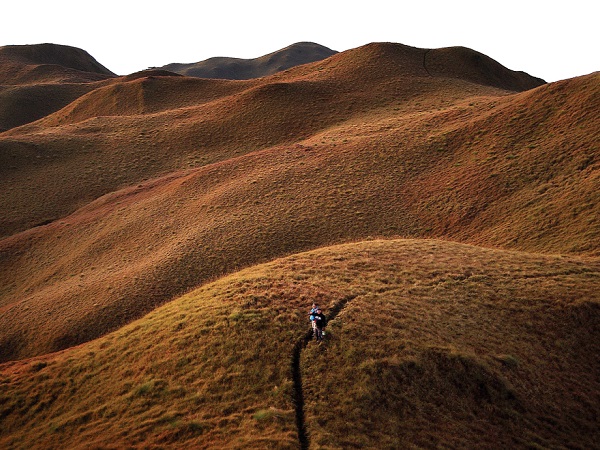
(Editor’s Note: Myk Miguel, a member of Zeta Mountaineering Group of the Zeta Phi Sigma fraternity, first conquered Mount Pulag in 1978. A professional photographer, he takes shots while discovering the beauty of the country’s highest peaks on foot.)
There ain’t no mountain high enough for these “nature trippers,” who have scaled the heights of the country’s highest peaks.
But in all its conquests, the trekkers of Zeta Mountaineering Group of Zeta Phi Sigma fraternity have found a favorite in Mount Pulag—Luzon’s highest summit.
So revisit the majestic peak the mountaineers did when the fraternity recently celebrated its 39th year. A member who was away for 30 years flew all the way from New York to join the reunion climb, along with this author, senior citizen card-bearing members and youthful recruits.
Colleagues who have dreamt of climbing every mountain but were already past their “peak”—no thanks to their failing knees and joints—sent us their best wishes.
Mt. Pulag brings us back to 1978, when we were first introduced to it by a member of the defunct Mountaineering Association of the Philippines. As we all agree, there’s no one tale to tell in all the decades of visiting this mountain in Benguet. Every hike was a different experience.
And every climb had a different story to tell about its lone inhabitant at the foot of the mountain, Apo Usok.
He’s actually Apo Batacagan, but he got his moniker from lowlanders who always saw him sitting in fetal position, creating smoke out of stacks of dried leaves and twigs from a nonthreatening distance, away from the tired hikers camping in his yard. That smoke, we assumed, represented prayers to the gods for the safe journey of the hikers.
His hut, sooty in its interior, was a hospitable place for rain-soaked mountaineers. Its wall was plastered with cow dung to fill up the gaps, thus, protecting him from bitter cold.
A member of the Kalanguya tribe, he earned his keep by selling pine tree resin to truckers who bought them in commercial quantities. Through hand gestures, we offered food and premium gin as token of gratitude as we said hellos or bid goodbyes.
‘Abortion road’
Gone were the days when the road leading to Bokod, Benguet, was called “abortion road,” in reference to its ruggedness. It is now fully concrete. Baguio-Bokod chartered jeepneys bound for Mt. Pulag can even be accessed via text messaging.
Gone is the sawmill in Ambangeg and its cable system that transported logs. The Chan See store which was the trading post in the area—as well as the watering hole of local loggers and gold panners—is gone as well.
We reached Babadac Ranger Station in less than an hour, a far cry from those days when we used to trek this trail in a day. It now looks a lot like a jeepney terminal in Pasay City, with 20 or more jeepneys lined up for shuttle hikers.
The association of porters-guides is well-organized; they issue receipts for fee payments, assign porters-guides (100 of them) on a rotation basis and weigh each backpack for porters.
At the back of the ranger station, which used to be Apo Usok’s domain and a historical site of Mt. Pulag, is now a forgotten hikers’ haven buried in pile of earth from a widened road. A pond closer to his hut, now dug up deep for watering vegetable farms, has been named after him, a mere consolation for being the first settler of this remote area.
We learned that he passed away in the early 1990s—then a centenarian—from a tragic fire in his hut.
A few meters past the ranger station was once the cul-de-sac of Ambangeg Trail. It was also the start of the mossy forest. Now, an appalling landscape appeared before our eyes. The place, now called Camp 1, is bare and idle.
Comparing a photo taken of this site from our 1980 hike would confirm the massive destruction of the forest—a nearly 2-kilometers stretch of it.
Bare landscape
What used to be a very narrow trail is now a bare landscape with a wide road for trucks to transport farm produce. Mt. Pulag National Park is now the food basket of the north. Its verdant forest is gone and has been transformed into upland vegetable farms.
Reaching the edge of the not-so-mossy forest is the grassland—a revelation of the grandeur of the “bald mountain” or “playground of the gods.” From there, on a bright day, tired hikers would be rejuvenated upon seeing a magnificent landscape of rolling hills—brown in the summer, green on rainy days.
It is called Camp 2 and it is mandatory to camp there. I could visualize a sea of tents in different colors being set up there simultaneously by hundreds of mountaineers and would mimic the scene in the Woodstock Music Festival of 1969.
I don’t mind seeing latrines because it’s the best thing the park management could do for hikers responding to repeated calls of nature.
We used to treasure the carpet-like growth of Bermuda grass on the grassland trail. There are scarce patches of them now, its growth hampered by seemingly perpetual steps of hiking boots.
Of course, the coldness of the night is one of the come-ons of the mountain, being the “roof” of Luzon. The peak climbing season is January and February, when below-zero temperature is much sought after.
Well, mountaineers are sometimes called masochists for finding pleasure in the discomfort of the wild. We are now prepared for the cold night with modern tents, parkas, gloves and butane stoves for bottomless servings of coffee. Of course, we still brag about our antiquated boy-scout tent made of canvas.
Climate change took its toll on us because heavy fog prohibited us—as well as other hikers of the previous days—from assaulting the summit. That week was supposed to be the start of summer season. That’s the reality in camping: Campers need to abide and accept what Mother Nature gives. We promised to ourselves to return for better luck.
Historical legacy
Disappointed but not down, the members took turns in taking photos. Some were using the latest iPhone apps. Waiting till 9 a.m., with the landscape still shrouded with fog, we came to terms with the fact that we needed to break camp.
Quo vadis, Mt. Pulag? With tens of thousands of hikers—16,000 of them visited last year, according to the Department of Environment and Natural Resources (DENR)—chasing a sea of clouds and the spectacular sunrise, the ecotourism business may be good for the porters-guides, the local government of Kabayan and the DENR. Can they be advocates of the sanctity of the mountain by imposing more measures to prevent overuse of the park and not welcoming outsiders to damage the protected area?
Quo vadis, Mt. Pulag? Apo Usok’s historical legacy is buried in oblivion and his memories are trampled upon in the name of agri-business and ecotourism. I think the smoke signals he created conveyed another message: That the gods forbid strangers from desecrating the mountain.
There must be something concrete to be done. In 1987, former President Cory Aquino signed Proclamation No. 75 declaring Mt. Pulag National Park. Her son, the current President Aquino, signed Executive Order No. 26, known as the National Greening Program, which seeks to plant 1.5 billion trees before his term ends in 2016. These two presidential initiatives blend well in a reforestation program.
Leading this noble cause would be the DENR and the local government of Kabayan, which would provide trees for planting. The muscles would be the mountaineers—thousands of them—who would be happy to volunteer to restore the beauty of the park. Private corporations and public offices could adopt certain lots as their corporate social responsibilities. To complete the team, the inhabitants of the area, including the porter-guides and the descendants of Apo Usok, would be the caretakers of this soon-to-be forest. Let’s bring the legacy of People Power to Mt. Pulag.
On the tail-end of summer, mountaineers and newbies are still set to climb Mt. Pulag. There is still plenty of time to prepare for the adventure. Good hiking shoes, tent, thermal wear and jacket (for the coldest night one would experience), camping stove (coffee tastes better up there), sturdy legs and healthy lungs (for high altitude hiking) and the last important thing—a digital camera to record the breathtaking view Mt. Pulag is known for.












































